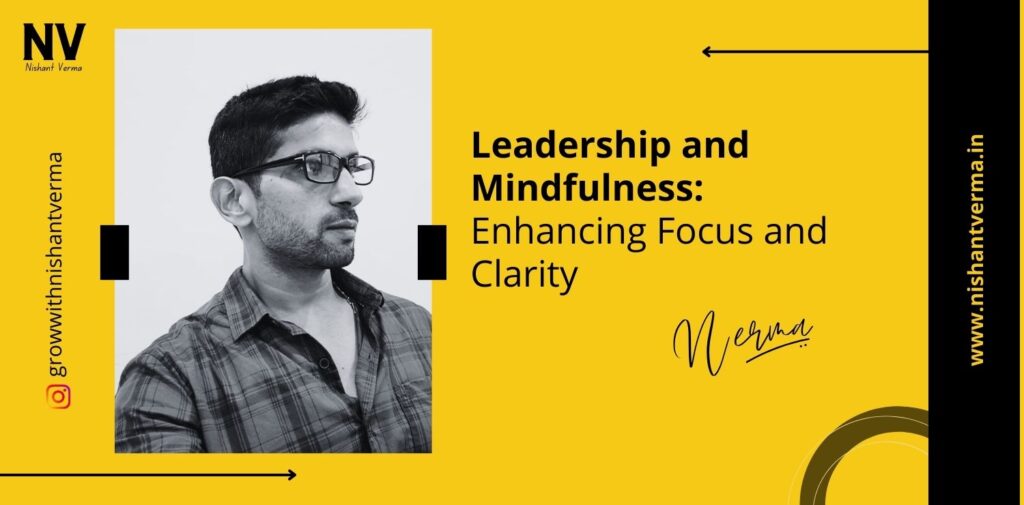Leadership and Mindfulness elaborates that In the busy world of leadership, where things move really fast and leaders have tons of things to do, mindfulness has become a super helpful tool. Mindfulness is like a special skill that helps leaders stay focused and think clearly, especially when facing challenges or making important decisions. It’s all about being in the moment and paying attention to what’s happening around you. In this article, we’re going to dive into how mindfulness can make a big difference in leadership. We’ll talk about what mindfulness is, why it’s so powerful for leaders, and share some easy ways leaders can start using mindfulness every day.

I. Understanding Mindfulness:
What is Mindfulness?
Mindfulness is the practice of paying attention to the present moment without judgment. It involves fully engaging in whatever you are doing, whether making decisions, listening to others, or simply taking a moment for yourself. Mindfulness is a mental superpower. It means paying close attention to what’s going on right now without getting all stressed or judgmental about it. Imagine being fully into whatever you’re doing, whether it’s making decisions or just taking a moment for yourself.
The Science Behind Mindfulness:
Research has shown that mindfulness practices can positively affect the brain, reducing stress, improving focus, and enhancing emotional regulation. For leaders facing constant pressure, cultivating a mindful mindset can be a game-changer.
II. The Benefits of Mindful Leadership:
Enhanced Focus:
Mindfulness helps leaders cut through the noise and concentrate on the task. By training the mind to stay present, leaders can make more informed decisions and avoid being overwhelmed by distractions.
Improved Clarity in Decision-Making:
Leaders often face complex decisions. Mindfulness provides a mental space for clearer thinking, enabling leaders to consider various perspectives, weigh options, and make decisions that align with their values and the organization’s goals.
Stress Reduction:
The demands of leadership can be stressful. Mindfulness techniques, such as deep breathing and meditation, help leaders manage stress more effectively, promoting overall well-being and preventing burnout.
Better Emotional Regulation:
Emotional intelligence is a key trait in effective leaders. Mindfulness fosters self-awareness and emotional regulation, allowing leaders to respond thoughtfully rather than impulsively in challenging situations.

III. Practical Strategies for Mindful Leadership:
Mindful Practices for Daily Routine:
Integrating mindfulness into daily routines can be simple yet impactful. Leaders can start with short mindfulness exercises, such as mindful breathing or a brief meditation, to set a positive tone for the day.
Active Listening:
Mindful leaders practice active listening, giving full attention to others without interrupting or pre-judging. This strengthens relationships and ensures that leaders understand the nuances of a situation before making decisions.
Mindful Decision-Making:
Before making significant decisions, leaders can take a moment to centre themselves. This pause allows for a clearer perspective and helps leaders avoid impulsive choices.
Mindful Communication:
Leaders who practice mindful communication choose their words carefully, considering the impact on others. This fosters a positive and inclusive organizational culture.

IV. Overcoming Challenges in Adopting Leadership and Mindfulness:
Cultivating Patience:
Mindfulness is a skill that develops over time. Leaders may face challenges initially, but with patience and persistence, they can integrate mindfulness into their leadership style.
Overcoming Resistance:
Some leaders may be sceptical of mindfulness. Addressing misconceptions and highlighting the tangible benefits to encourage wider adoption is essential.
V. Case Studies: Real-Life Examples of Mindful Leadership:
Google’s Search Inside Yourself Program:
Google implemented a mindfulness program, “Search Inside Yourself,” which has successfully improved focus, emotional intelligence, and overall well-being among employees and leaders.
Aetna’s Mindfulness Initiatives:
Aetna, a healthcare company, introduced mindfulness programs that reduced stress levels, improved employee satisfaction, and increased productivity.
VI. Conclusion:
In the world of leadership, where challenges come at you all the time and decisions really matter, mindfulness is like a secret superpower. It helps leaders become better at handling everything that comes their way. Imagine having a tool that makes your mind clear, focused, and strong – that’s what mindfulness does.
When leaders use mindfulness, they learn to stay calm in the middle of chaos. It’s like having a shield against the constant challenges leaders face. By practising mindfulness every day and using it when making important decisions, leaders create a positive vibe in their workplace. This good vibe spreads to everyone, making the whole team happier and more effective.
Mindfulness isn’t some complicated thing – it’s about paying attention to what’s happening right now without getting all stressed about it. Leaders who do this find that they can make better choices because they aren’t getting carried away by worries or distractions.
Imagine a leader who starts the day with a few moments of mindfulness, just taking a breath and clearing their mind. That leader goes into the day with a positive attitude and is better prepared to handle whatever comes up. When faced with tough decisions, a mindful leader takes a moment to think clearly, avoiding rushed choices that might not be the best.
As more and more leaders discover the power of mindfulness, it’s not just a trend – it’s becoming a game-changer for the future of leadership. The cool thing is that it’s not complicated or hard to do. It’s a simple practice that leaders can weave into their daily routines, making them better at their jobs and creating a workplace where everyone feels good about what they’re doing.
In a nutshell, mindfulness is like a superhero tool for leaders. It helps them stay focused, make clear decisions, and lead their teams with a positive vibe. As leaders everywhere catch on to the benefits of mindfulness, it’s not just a cool thing to try – it’s shaping the way leaders lead and making the future of leadership look brighter than ever.




